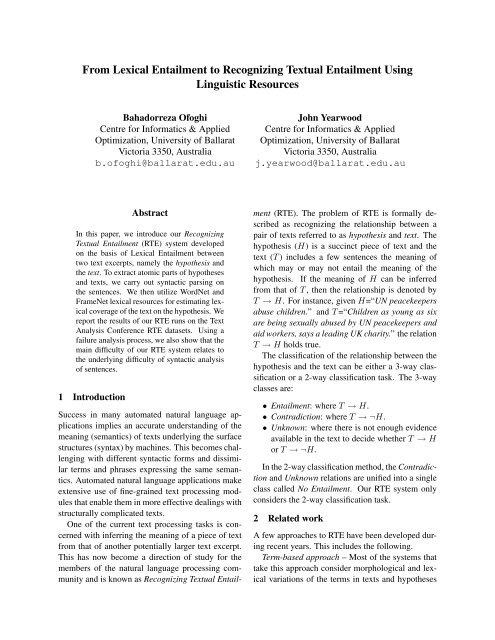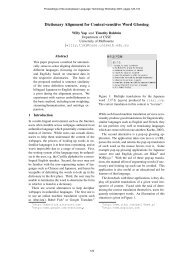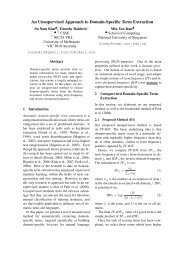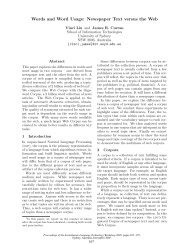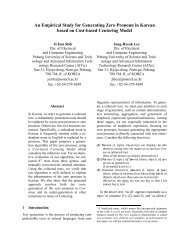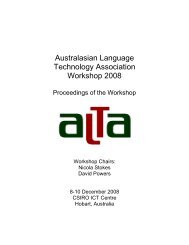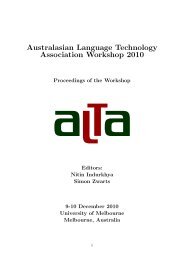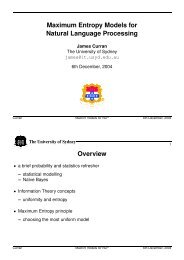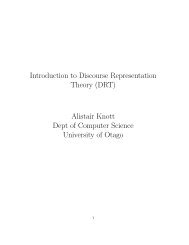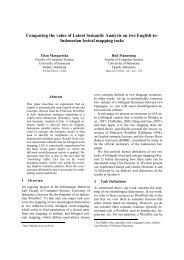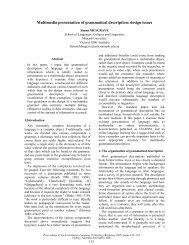From Lexical Entailment to Recognizing Textual Entailment Using ...
From Lexical Entailment to Recognizing Textual Entailment Using ...
From Lexical Entailment to Recognizing Textual Entailment Using ...
You also want an ePaper? Increase the reach of your titles
YUMPU automatically turns print PDFs into web optimized ePapers that Google loves.
<strong>From</strong> <strong>Lexical</strong> <strong>Entailment</strong> <strong>to</strong> <strong>Recognizing</strong> <strong>Textual</strong> <strong>Entailment</strong> <strong>Using</strong><br />
Linguistic Resources<br />
Bahadorreza Ofoghi<br />
Centre for Informatics & Applied<br />
Optimization, University of Ballarat<br />
Vic<strong>to</strong>ria 3350, Australia<br />
b.ofoghi@ballarat.edu.au<br />
John Yearwood<br />
Centre for Informatics & Applied<br />
Optimization, University of Ballarat<br />
Vic<strong>to</strong>ria 3350, Australia<br />
j.yearwood@ballarat.edu.au<br />
Abstract<br />
In this paper, we introduce our <strong>Recognizing</strong><br />
<strong>Textual</strong> <strong>Entailment</strong> (RTE) system developed<br />
on the basis of <strong>Lexical</strong> <strong>Entailment</strong> between<br />
two text excerpts, namely the hypothesis and<br />
the text. To extract a<strong>to</strong>mic parts of hypotheses<br />
and texts, we carry out syntactic parsing on<br />
the sentences. We then utilize WordNet and<br />
FrameNet lexical resources for estimating lexical<br />
coverage of the text on the hypothesis. We<br />
report the results of our RTE runs on the Text<br />
Analysis Conference RTE datasets. <strong>Using</strong> a<br />
failure analysis process, we also show that the<br />
main difficulty of our RTE system relates <strong>to</strong><br />
the underlying difficulty of syntactic analysis<br />
of sentences.<br />
1 Introduction<br />
Success in many au<strong>to</strong>mated natural language applications<br />
implies an accurate understanding of the<br />
meaning (semantics) of texts underlying the surface<br />
structures (syntax) by machines. This becomes challenging<br />
with different syntactic forms and dissimilar<br />
terms and phrases expressing the same semantics.<br />
Au<strong>to</strong>mated natural language applications make<br />
extensive use of fine-grained text processing modules<br />
that enable them in more effective dealings with<br />
structurally complicated texts.<br />
One of the current text processing tasks is concerned<br />
with inferring the meaning of a piece of text<br />
from that of another potentially larger text excerpt.<br />
This has now become a direction of study for the<br />
members of the natural language processing community<br />
and is known as <strong>Recognizing</strong> <strong>Textual</strong> <strong>Entailment</strong><br />
(RTE). The problem of RTE is formally described<br />
as recognizing the relationship between a<br />
pair of texts referred <strong>to</strong> as hypothesis and text. The<br />
hypothesis (H) is a succinct piece of text and the<br />
text (T ) includes a few sentences the meaning of<br />
which may or may not entail the meaning of the<br />
hypothesis. If the meaning of H can be inferred<br />
from that of T , then the relationship is denoted by<br />
T → H. For instance, given H=“UN peacekeepers<br />
abuse children.” and T =“Children as young as six<br />
are being sexually abused by UN peacekeepers and<br />
aid workers, says a leading UK charity.” the relation<br />
T → H holds true.<br />
The classification of the relationship between the<br />
hypothesis and the text can be either a 3-way classification<br />
or a 2-way classification task. The 3-way<br />
classes are:<br />
• <strong>Entailment</strong>: where T → H.<br />
• Contradiction: where T → ¬H.<br />
• Unknown: where there is not enough evidence<br />
available in the text <strong>to</strong> decide whether T → H<br />
or T → ¬H.<br />
In the 2-way classification method, the Contradiction<br />
and Unknown relations are unified in<strong>to</strong> a single<br />
class called No <strong>Entailment</strong>. Our RTE system only<br />
considers the 2-way classification task.<br />
2 Related work<br />
A few approaches <strong>to</strong> RTE have been developed during<br />
recent years. This includes the following.<br />
Term-based approach – Most of the systems that<br />
take this approach consider morphological and lexical<br />
variations of the terms in texts and hypotheses
and determine the existence of entailment between<br />
the texts and hypotheses by means of their lexical<br />
similarities (Braz et al., 2005; Pazienza et al., 2005;<br />
Rodrigo et al., 2008).<br />
Logic-proving approach – The systems that follow<br />
this approach apply elements of classical or<br />
plausible logic <strong>to</strong> infer whether the meaning of the<br />
text entails that of the hypothesis. The logical<br />
procedures are called on a number of feature elements<br />
of the texts and hypotheses such as propositions<br />
or other logic forms (Akhma<strong>to</strong>va and Molla,<br />
2006; Tatu and Moldovan, 2005; Clark and Harrison,<br />
2008).<br />
Syntax-based approach – Some existing systems<br />
carry out a similarity analysis between the dependency<br />
trees extracted from the texts and hypotheses<br />
in order <strong>to</strong> identify the entailment relationships (Lin<br />
and Pantel, 2001; Kouylekov and Magnini, 2005;<br />
Yatbaz, 2008). There are also systems that take a<br />
paraphrase detection strategy <strong>to</strong> generate a set of<br />
different styles of the hypotheses with the aim of<br />
searching for a subset of which may occur in the<br />
texts (Bosma and Callison-Burch, 2006).<br />
Semantic role-based approach – There are systems<br />
that annotate the sentences of the texts and hypotheses<br />
with semantic roles (using shallow semantic<br />
parsers) and then analyze the coincidences between<br />
sets of assigned semantic roles (Braz et al.,<br />
2005).<br />
Knowledge-based approach – The utilization of<br />
world knowledge in these systems facilitates recognizing<br />
entailment relationships where existing lexical<br />
or semantic knowledge is not adequate for confidently<br />
inferring the relationships. One available<br />
structure that is moving <strong>to</strong>wards formulating world<br />
knowledge is Cyc 1 . We have not found any previous<br />
RTE system that uses Cyc.<br />
Our RTE system takes the term-based (lexical)<br />
approach <strong>to</strong> make decisions about textual entailment<br />
relationships.<br />
3 System architecture<br />
3.1 Preprocessing and sentence extraction<br />
The preprocessing stage is necessary in order for<br />
sentence extraction and the syntactic analysis of the<br />
sentences <strong>to</strong> be successfully carried out. Our RTE<br />
1 http://www.cyc.com/<br />
system performs some basic grammatical and punctuation<br />
fixes, such as adding a “.” at the end of sentences<br />
if the “.” is missing or capitalizing the first<br />
letter of a sentence if necessary.<br />
We utilize the LingPipe 2 sentence splitter <strong>to</strong> extract<br />
sentences from hypotheses and texts.<br />
3.2 Proposition extraction<br />
Propositions are extracted from each sentence in the<br />
hypothesis and the text. A proposition is an a<strong>to</strong>mic<br />
representation of concepts in the texts in which there<br />
are no clauses or dependent parts of texts included.<br />
For instance, from the sentence “The girl playing<br />
tennis is not my friend.” the proposition “girl playing<br />
tennis” can be extracted.<br />
Table 1: New syntactic rules for extracting propositions<br />
Linkage<br />
AN-Mg<br />
AN-Ss/Sp-<br />
MVp-Js/Jp<br />
Ss/Spx-<br />
Pg*b-Pv-<br />
MVp-Js/Jp<br />
Elements<br />
AN: connects noun modifiers <strong>to</strong> nouns, Mg:<br />
connects certain prepositions <strong>to</strong> nouns<br />
S : connects subjects <strong>to</strong> verbs, MVp: connects<br />
prepositions <strong>to</strong> verbs, J : connects<br />
prepositions <strong>to</strong> their objects<br />
Pg*b: connects verbs <strong>to</strong> present participles,<br />
Pv: connects forms of “be” <strong>to</strong> passive participles<br />
To extract propositions, we use Link Grammar<br />
Parser (LGP) (Slea<strong>to</strong>r and Temperley, 1993) and<br />
follow the procedure explained in (Akhma<strong>to</strong>va and<br />
Molla, 2006). There are seven rules introduced<br />
in (Akhma<strong>to</strong>va and Molla, 2006) and three new rules<br />
that we have developed for extracting propositions.<br />
Table 1 shows our new syntactic rules. Given the<br />
sentence “Children are being sexually abused by<br />
peacekeepers.”, for instance, the output parse will<br />
be like what is shown in Figure 1. <strong>From</strong> this, we are<br />
able <strong>to</strong> extract the proposition “peacekeepers abuse<br />
children.”.<br />
3.3 Lemmatization<br />
Before semantic alignment is carried out, all hypothesis<br />
and text terms are lemmatized using TreeTagger<br />
(Schmid, 1994). This means that the terms are<br />
unified <strong>to</strong> their single lemma like the transformation<br />
of the terms “abusing” and “abused” <strong>to</strong> the lemma<br />
“abuse”.<br />
2 Alias-i. 2008. LingPipe 3.8.2. http://alias-i.com/lingpipe.
Xp<br />
Pv<br />
Wd Spx Pg*b<br />
E MVp Jp<br />
LEFT-WALL children.n are.v being.v sexually abused.v by peacekeepers[!].n .<br />
Figure 1: LGP output of the sentence “Children are being sexually abused by peacekeepers.”<br />
3.4 <strong>Entailment</strong> checking<br />
We finally check the entailment between each pair of<br />
propositions extracted from the hypothesis and the<br />
text. The idea here is that the truth of each single<br />
proposition in the hypothesis needs <strong>to</strong> be entailed at<br />
least by the meaning of a proposition in the text in<br />
order for our RTE system <strong>to</strong> decide whether the text<br />
entails the truth of the hypothesis.<br />
Checking the pairwise entailment between propositions<br />
in our work focuses on the lexical items occurring<br />
in the propositions. At this stage, we find the<br />
relationships between pairs of lexical items in the<br />
propositions regardless of their position. If all lexical<br />
items of the hypothesis proposition have related<br />
terms in the text proposition, then the decision is<br />
that the hypothesis proposition is entailed by the text<br />
proposition and an <strong>Entailment</strong> relation is assigned <strong>to</strong><br />
the pair; otherwise, a No <strong>Entailment</strong> relation is assigned<br />
<strong>to</strong> the hypothesis-text pair.<br />
We use two lexical resources, WordNet (Miller et<br />
al., 1990) and FrameNet (Baker et al., 1998), <strong>to</strong> find<br />
relationships between different lexical items. When<br />
using WordNet, we assume that a term is semantically<br />
interchangeable with its exact occurrence, its<br />
synonyms, and its hypernyms. In extracting hypernyms,<br />
we only traverse the path in the corresponding<br />
WordNet synset for two links.<br />
In utilizing FrameNet, if two lexical items are<br />
covered in a single FrameNet frame, then the two<br />
items are treated as semantically related in our<br />
work. The two verbs “fly” and “pace”, for instance,<br />
are covered in (inherited from) the same<br />
FrameNet frame “Self motion”; therefore, we assume<br />
that these two verbs are semantically interchangeable.<br />
This type of event-based similarity is<br />
not encoded in WordNet.<br />
In cases where there is no proposition extracted<br />
for hypothesis and/or text sentences, the whole hypothesis<br />
and/or text sentences are taken <strong>to</strong> the step<br />
of entailment checking after their terms are lemmatized.<br />
In such cases, we use the Levenstein edit Distance<br />
(LD) between the hypothesis and the text. We<br />
use a shallow procedure where the LD distance takes<br />
characters as arguments. If the LD distance between<br />
a hypothesis and a text sentence is lower than a predefined<br />
threshold, then we infer that the text entails<br />
the hypothesis.<br />
4 Experiments<br />
4.1 Data<br />
We have run our RTE system on three datasets provided<br />
by the Text Analysis Conference (TAC) 3 for<br />
the RTE track:<br />
• TAC-RTE 2008 test dataset (rte4 - test), that includes<br />
1000 pairs of hypotheses and texts.<br />
• TAC-RTE 2009 main task development dataset<br />
(rte5 - dev.), that includes 600 pairs of hypotheses<br />
and texts.<br />
• TAC-RTE 2009 main task test dataset (rte5 -<br />
test), that includes 600 pairs of hypotheses and<br />
texts.<br />
4.2 Results<br />
We have carried out experiments with our baseline<br />
RTE system where:<br />
• The verbs are extended using FrameNet,<br />
• The noun phrases are extended using WordNet,<br />
• The WordNet distance threshold for finding hypernyms<br />
is equal <strong>to</strong> 1,<br />
• The LD distance, in cases where proposition<br />
extraction fails, is equal <strong>to</strong> 3, and<br />
• The term coverage procedure considers all<br />
terms in hypotheses (propositions) <strong>to</strong> have corresponding<br />
terms in texts (propositions).<br />
In the TAC-RTE 2008 dataset, there are four categories<br />
of hypothesis-text pairs for Question Answering<br />
(QA), Information Extraction (IE), and Information<br />
Retrieval (IR), and Summarization (SUM)<br />
3 http://www.nist.gov/tac/
tasks. In the TAC-RTE 2009 datasets, however,<br />
there are only pairs for QA, IE, and IR tasks. We report<br />
the accuracy and the recall of our RTE system<br />
for these categories and the two classes <strong>Entailment</strong><br />
and No <strong>Entailment</strong> in Table 2 and Table 3. For the<br />
RTE5 test dataset, we still do not have access <strong>to</strong> the<br />
answer set; therefore, recall cannot be measured at<br />
this stage.<br />
Table 2: Accuracy of our baseline RTE runs on the RTE4<br />
and RTE5 datasets – Avg. is a macro average<br />
Dataset<br />
Accuracy<br />
QA IE IR SUM Avg.<br />
rte4 - test 0.480 0.500 0.506 0.490 0.496<br />
rte5 - dev. 0.480 0.470 0.520 N/A 0.490<br />
rte5 - test 0.485 0.505 0.510 N/A 0.500<br />
Table 3: Detailed analysis of our baseline RTE runs on<br />
the RTE4 and RTE5 datasets<br />
Dataset<br />
Correctly classified Recall<br />
ent. No ent. ent. No ent.<br />
rte4 - test 70 426 0.140 0.852<br />
rte5 - dev. 25 269 0.083 0.896<br />
rte5 - test N/A N/A N/A N/A<br />
4.3 Discussion<br />
As shown in Table 2, an average accuracy of 0.500<br />
on the RTE5 test dataset is our best achievement so<br />
far where in our previous runs our baseline RTE system<br />
achieves an average accuracy of 0.496 and 0.490<br />
for the RTE4 test and RTE5 development datasets.<br />
A more detailed analysis of these results in Table<br />
3 shows that our RTE system has not been very<br />
successful in recognizing correct entailment relationships.<br />
On the RTE4 test dataset, the entailment<br />
recall of 0.140 for 70 correctly classified items (out<br />
of 500 pairs) and on the RTE5 development dataset,<br />
the entailment recall of 0.083 for only 25 correctly<br />
classified items (out of 300 pairs) do not show high<br />
effectiveness in entailment recognition. Although<br />
with the accuracy measures obtained for the RTE5<br />
test dataset we expect <strong>to</strong> see comparable classification<br />
performance and recall measures for the RTE5<br />
test dataset, we do not have access <strong>to</strong> the gold standard<br />
test set and cannot report on these items for this<br />
dataset.<br />
The overall statistics of the TAC-RTE 2009 systems<br />
shows the high, median, and low 2-way classification<br />
accuracies of 0.7350, 0.6117, and 0.5000<br />
respectively. The overall performance of our RTE<br />
system does not reach high levels of accuracy, compared<br />
with the TAC-RTE 2009 statistics. We have<br />
conducted a failure analysis process <strong>to</strong> understand<br />
the underlying difficulty of the system.<br />
4.4 System failure analysis<br />
We have carried out an error analysis process of our<br />
baseline RTE system on the RTE4 test and the RTE5<br />
development and test datasets with particular attention<br />
<strong>to</strong> syntactic parsing leading <strong>to</strong> proposition extraction.<br />
Table 4 summarizes the result of this analysis<br />
where hypo stands for hypothesis and both refers<br />
<strong>to</strong> the intersection of the sets of hypotheses and texts.<br />
The major barrier that interferes with our RTE system’s<br />
performance seems <strong>to</strong> be the syntactic parsing<br />
stage where for the RTE4 test dataset, there are<br />
131+320-57=394 hypotheses and texts for which no<br />
parses are returned by LGP. Therefore, the system<br />
has access <strong>to</strong> the parse of only ∼60% of the dataset<br />
<strong>to</strong> extract propositions. For the RTE5 development<br />
dataset this ratio is ∼80% of the dataset.<br />
<strong>From</strong> another viewpoint, for the RTE4 test dataset<br />
there are 453+574-261=766 hypotheses and texts <strong>to</strong>gether<br />
where no propositions can be extracted for<br />
either the hypothesis or the text sentences. As a result,<br />
the semantic expansion and entailment checking<br />
procedures have access <strong>to</strong> proposition-level information<br />
for ∼23% of the pairs in the RTE4 test<br />
dataset. For the RTE5 development dataset, this ratio<br />
is ∼29% of the pairs.<br />
Table 4: Error analysis of our baseline RTE runs on the<br />
RTE4 test and the RTE5 development datasets<br />
Dataset<br />
No parse<br />
No prop.<br />
hypo text both hypo text both<br />
rte4 - test 131 320 57 453 574 261<br />
rte5 - dev. 58 60 2 352 192 119<br />
We believe that, <strong>to</strong> improve the effectiveness of<br />
our lexical (term-based) RTE system, there is a need<br />
for further elaboration in two aspects:<br />
• Syntactic parsing, using a more capable<br />
parser that is less sensitive <strong>to</strong> the grammati-
cal/structural flaws in texts and can more effectively<br />
handle long sentences, and<br />
• Proposition extraction, by extracting/learning<br />
and utilizing a greater number of rules <strong>to</strong> extract<br />
propositions from parsed sentences.<br />
5 Conclusion<br />
A lexical <strong>Recognizing</strong> <strong>Textual</strong> <strong>Entailment</strong> (RTE)<br />
system participated in the Text Analysis Conference<br />
(TAC) 2009 has been introduced in this paper.<br />
This 2-way RTE system utilizes a syntactic approach<br />
prior <strong>to</strong> the term-based analysis of the hypotheses<br />
and texts in identification of entailment relationships.<br />
The results of our RTE system on three datasets of<br />
the TAC-RTE tracks have been reported and shown<br />
moderate performances for our system. We have<br />
carried out a failure analysis of this RTE system <strong>to</strong><br />
understand the underlying difficulties that interfere<br />
with the system performances. This has shown that<br />
the syntactic analysis of the hypotheses and texts,<br />
where sentences are parsed and propositions are extracted,<br />
is the main challenge that our system faces<br />
at this stage.<br />
References<br />
Elena Akhma<strong>to</strong>va and Diego Molla. 2006. <strong>Recognizing</strong><br />
textual entailment via a<strong>to</strong>mic propositions. In Proceedings<br />
of the Machine Learning Challenges Workshop<br />
(MLCW), 385–403. Southamp<strong>to</strong>n, UK.<br />
Collin F. Baker, Charles J. Fillmore, and John B. Lowe.<br />
1998. The Berkeley FrameNet project. In Proceedings<br />
of the 17th International Conference on Computational<br />
Linguistics (COLING, 86–90. Universite de<br />
Montreal, Montreal, Quebec, Canada.<br />
W.E. Bosma and C. Callison-Burch. 2006. Paraphrase<br />
substitution for recognizing textual entailment. In<br />
Working Notes of CLEF 2006, 1–8. Alicante, Spain.<br />
Peter Clark and Phil Harrison. 2008. <strong>Recognizing</strong> textual<br />
entailment with logic inference. In Proceedings<br />
of the Fourth PASCAL Challenges Workshop on <strong>Recognizing</strong><br />
<strong>Textual</strong> <strong>Entailment</strong>. Gaithersburg, Maryland,<br />
USA.<br />
M. Kouylekov and B. Magnini. 2005. <strong>Recognizing</strong><br />
textual entailment with tree edit distance algorithms.<br />
In Proceedings of the First PASCAL Challenges<br />
Workshop on <strong>Recognizing</strong> <strong>Textual</strong> <strong>Entailment</strong>,<br />
17–20. Southamp<strong>to</strong>n, UK.<br />
D. Lin and P. Pantel. 2001. DIRT - Discovery of inference<br />
rules from text. In Proceedings of the ACM<br />
SIGKDD Conference on Knowledge Discovery and<br />
Data Mining, 323–328. San Francisco, California,<br />
USA.<br />
George A. Miller, R. Beckwith, C. Fellbaum, D. Gross,<br />
and K. J. Miller. 1990. Introduction <strong>to</strong> WordNet: An<br />
on-line lexical database. International Journal of Lexicography,<br />
3(4):235–244.<br />
M. T. Pazienza, M. Pennacchiotti, and F. M. Zanzot<strong>to</strong>.<br />
2005. <strong>Textual</strong> entailment as syntactic graph distance:<br />
A rule based and a SVM based approach. In Proceedings<br />
of the First PASCAL Challenges Workshop on<br />
<strong>Recognizing</strong> <strong>Textual</strong> <strong>Entailment</strong>, 25–28. Southamp<strong>to</strong>n,<br />
UK.<br />
Alvaro Rodrigo, Anselmo Penas, and Felisa Verdejo.<br />
2008. Towards an entity-based recognition of textual<br />
entailment. In Proceedings of the Fourth PASCAL<br />
Challenges Workshop on <strong>Recognizing</strong> <strong>Textual</strong> <strong>Entailment</strong>.<br />
Gaithersburg, Maryland, USA.<br />
R. de Salvo Braz, R. Girju, V. Punyakanok, D. Roth, and<br />
M. Sammons. 2005. <strong>Textual</strong> entailment recognition<br />
based on dependency analysis and WordNet. In Proceedings<br />
of the First PASCAL Challenges Workshop on<br />
<strong>Recognizing</strong> <strong>Textual</strong> <strong>Entailment</strong>, 29–32. Southamp<strong>to</strong>n,<br />
UK.<br />
Daniel Slea<strong>to</strong>r and Davy Temperley. 1993. Parsing English<br />
with a link grammar. In Proceedings of the Third<br />
International Workshop on Parsing Technologies.<br />
Helmut Schmid. 1994. Probabilistic part-of-speech<br />
tagging using decision trees. In Proceedings of the<br />
Conference on New Methods in Language Processing.<br />
Manchester, UK.<br />
Marta Tatu and Dan Moldovan. 2005. A semantic approach<br />
<strong>to</strong> recognizing textual entailment. In Proceedings<br />
of the conference on Human Language Technology<br />
and Empirical Methods in Natural Language Processing<br />
(HLT-EMNLP), 371–378. Vancouver, British<br />
Columbia, Canada.<br />
Mehmet Ali Yatbaz. 2008. RTE4: Normalized dependency<br />
tree alignment using unsupervised n-gram word<br />
similarity score. In Proceedings of the Fourth PASCAL<br />
Challenges Workshop on <strong>Recognizing</strong> <strong>Textual</strong> <strong>Entailment</strong>.<br />
Gaithersburg, Maryland, USA.


